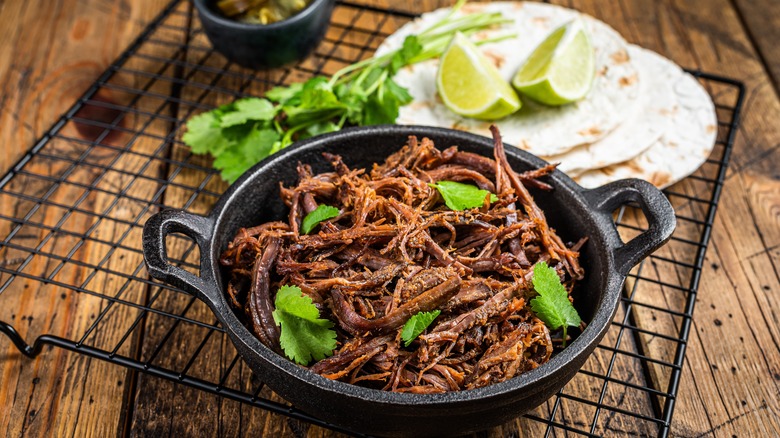What Kind Of Meat Should You Use For Carnitas?
In the culinary landscape, there are certain classics that stand the test of time and transcend borders, thanks to passionate preservers who continue to champion centuries-old recipes. This is true of some taco-lovers' favorites and one such preparation is the carnitas taco. No matter the market in which you live, whether served with classic fresh pico de gallo or paired with a spicy margarita, your local Mexican spot will most likely offer this variation on its menu section. But what does that actually mean for what you'll find inside?
In Spanish the word "carnitas" translates to "little meats," which helps classify this filling as a protein but it's helpful to know that the classic version of this taco is made specifically from pork. This specific dish has many regional interpretations but is widely accepted to hail from Michoacan.
In Mexican history, this protein was a major part of the diet in European colonies, as there is a belief among some historians that pigs arrived in what would become Mexico to sustain Spanish soldiers under Hernan Cortes. Over time, the meat made its way into many dishes representative of Mexican culture and cuisine but thanks to an enduring method of preparation, those tacos made with "little meats" always deliver massive flavor.
What type of pork is used for carnitas
In terms of cuts, carnitas are usually made from well-marbled pork butt or shoulder, which will stand up to the lengthy cooking time and lend plenty of flavor from its inherent fat. Although, some suggest you can use a combination that includes anything from belly to feet to tongue. Whichever the choice, these are usually less pricey pieces of meat that benefit from a long, slow cook that will help it become tender and juicy.
During that process, the pork is simmered in a combination of spices and aromatics. Once that step is complete, the meat gets a quick fry in fat before shredding which can be achieved in a hot pan, oven, or even quickly broiled. This creates the signature crispiness and caramelized crust that distinguishes carnitas from a similar dish like pulled pork.
Carnitas is essentially a confit of pork, meaning the meat is simmered in fat. In this case, the traditional method utilizes manteca or a soft rendered type of pork lard. But if you don't happen to have manteca on hand, you can still make unforgettable carnitas at home by simmering your meat in your chosen liquid and creating that crispy finish with a cooking fat like vegetable oil. Some recipes also suggest that once the moisture has evaporated from your pork, you can simply allow its own natural fats to fry it.
What ingredients work best to flavor the pork for carnitas
Pork is a protein embraced by cuisines all over the world and with good reason. Its inherent profile hits so many crave-able notes, including natural sweetness and the all-important umami. Descriptors like rich and complex can be applied to the experience of eating pork and those qualities all lend themselves well to the flavors of carnitas.
When it comes to seasoning your carnitas, many recipes feature traditional elements that play to the pork's strengths. From spices like coriander, cumin, cinnamon, and paprika, alliums like garlic and onions or shallots, and aromatics like bay leaves and jalapeños. You'll find a range of combinations that can provide inspiration for your own personal version of this classic dish.
For simmering liquids, recipes may call one or more ingredients, from chicken broth, orange juice, Mexican Coca-Cola, and evaporated milk. You can simmer your meat on the stovetop, roast in the oven, or even create slow cooker pork carnitas tacos for a simple, mostly hands-off approach. Regardless of how you prep your carnitas, this recipe may give you a whole new appreciation for the deliciously versatile, always iconic pork.


